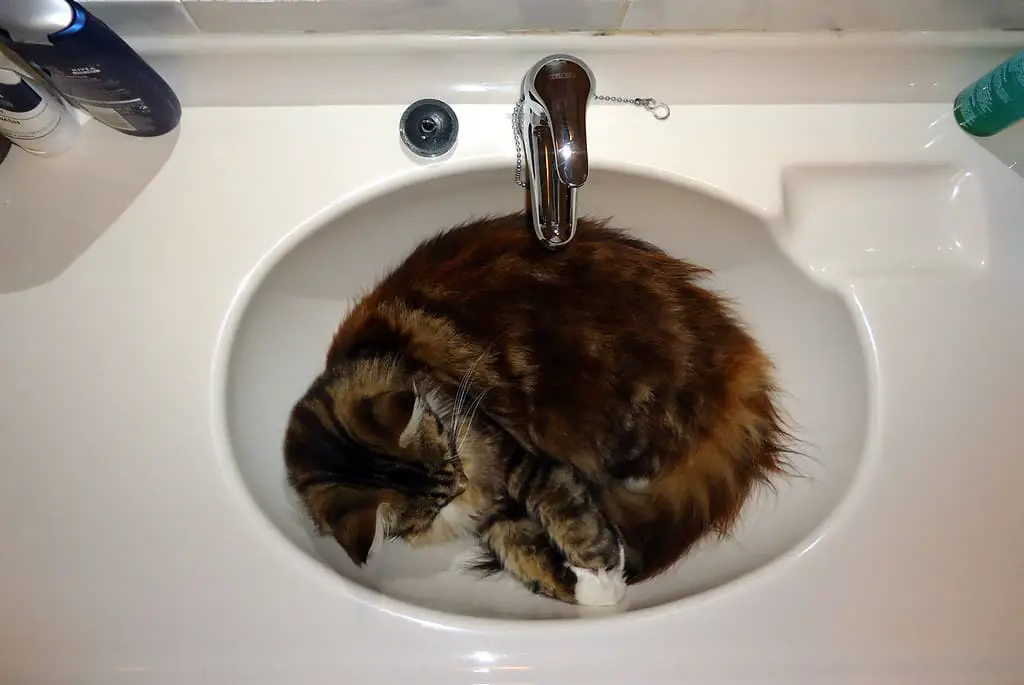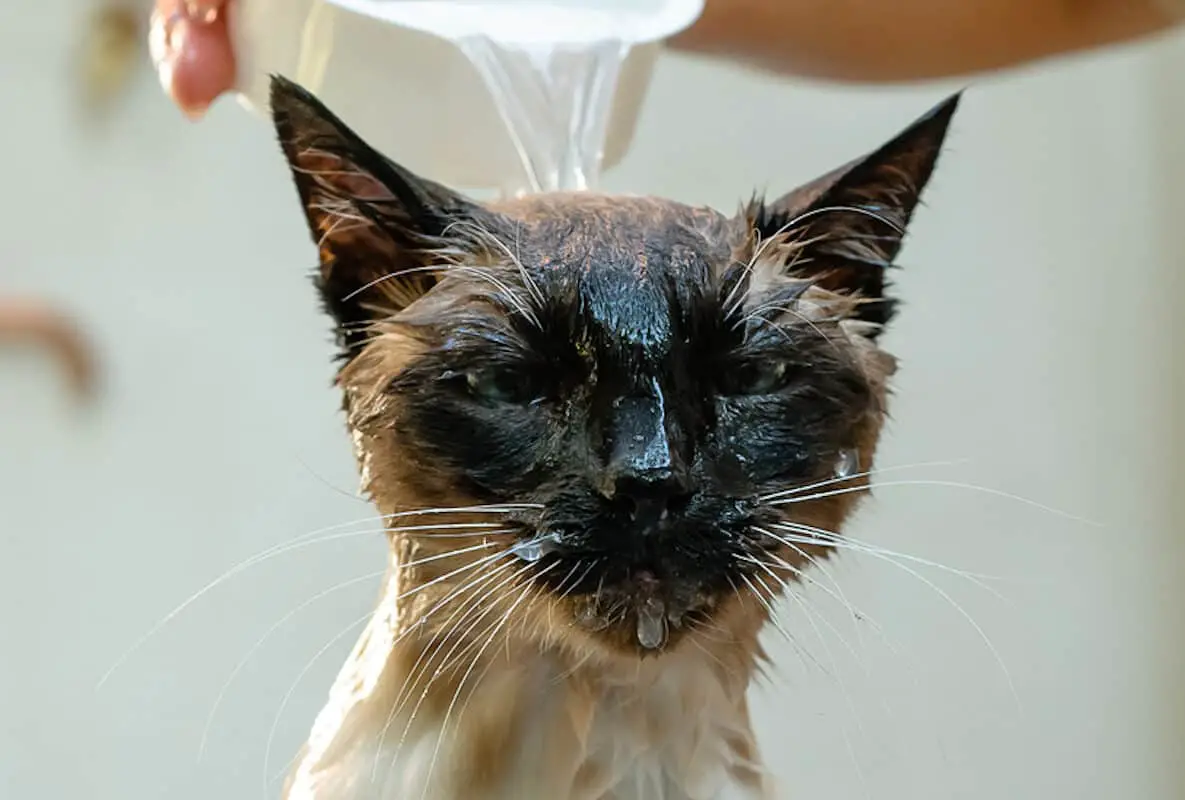Are you wondering how to bathe your Siamese cat without it throwing a tantrum and scratching you?
The key to bathing a (Siamese) cat is preparation. Gather all supplies and know how to go about it. Avoid getting their head wet and use a soft bath cloth with special cat shampoo.
But, there’s more to it than this. Next, we’ll go over how to make the whole process a positive experience for your cat and you.
Prepare for bath time
Preparing the bath area is the first step to successfully bathing your Siamese cat.
This is simple…
Protection
If you’re lucky enough to have a cat that likes or doesn’t mind getting wet, you are blessed.
However, 99% of cats want nothing to do with water and hate getting wet, let alone having a bath, especially not when forced to.
As soon as they figure out your intentions, most cats will start hissing, scratching, trying to escape, and splashing about.
So, for your own protection, it’s advisable to wear something with long sleeves. Preferable some clothing that can withstand cat scratches.
Did I mention not wearing your Sunday clothes? Wear something that you don’t mind being ripped to shreds.
Brush your cat’s fur
Before you bathe your cat, start by brushing its fur.
Not only is this an excellent opportunity to bond with your cat and to, hopefully, get her in the bathing mindset, but it’s also needed to get any knots and tangles out of her fur.
Most Siamese have nice short fur. Nevertheless, don’t skip this step.
When knots and tangles get wet, it will be much more challenging and painful for your cat to remove them. Since you’ll want the whole process to be as smooth as possible, remember to start with a good brushing session.
This is the part that is most enjoyable for your cat anyway.
To mentally prepare your Siamese for the upcoming bathing session, it’s a good idea to do the brushing in the bathroom (or the place where the bathing will happen).
It’s a great idea to brush them in the tub or sink before adding the water.
Prepare the bathing area
Although the bathtub or shower area might come to mind as the ideal bathing place, the kitchen sink is often a much better place.
Mainly because it’s much more comfortable for you to be standing rather than awkwardly bent over the edge of the tub or halfway into the shower.
If you’re lucky enough to have a double sink in your kitchen, you can use one of them to wash your Siamese and the other sink to rinse them off.
Wherever you choose to bathe your Siamese cat, it is essential to prepare the area and have everything you need within arm’s reach.
You don’t want to go looking for something while fending off a cat on one arm while looking for something.
Items to prepare are:
- A towel to wrap your cat into after bathing
- A towel to put at the bottom of the sink to prevent your cat from slipping and sliding while you wash her.
- A washcloth
- Soaps and shampoos that you’ll be using
- A hairdryer, preferably one with a variable temperature setting
Close the door
Next up, close the door. You do not want your cat jumping out of the sink and escaping and messing up your tidy home.
On the other hand, you also do not want other pets or children wandering into the bathroom to create more chaos, distraction, and confusion.

Preparing the tub
You should fill up the tub or sink with nice warm water.
Temperature
Cats have a higher internal body temperature than humans (around 100F-102F or 38C). This means that water we consider warm might feel cold to them.
Don’t make it so hot that it could burn their skin. Around the 100F mark should be comfortable and safe for your Siamese.
Fill the tub or sink up to where the water would just reach their chest when your cat stands up in the sink. At no point do you want to run the risk of your cat getting water in her mouth, nose, or eyes.
Keeping the water level relatively low also avoids your cat panicking.
Soap
Next, add some shampoo to the water and mix it up. Not too much, though. It shouldn’t look like a bubble bath, as that could freak your cat out.
If you prefer just soaping your cat with your hands, just like you would wash your own hair, that is fine too.
Although some people will say it’s OK to use any kind of (human) shampoo or dishwashing detergent, don’t do it.
These could contain harmful ingredients to a Siamese’s delicate skin and fur and may cause rashes, hair fall, and other nasty conditions that you’d better avoid.
Get some special cat shampoo; it’s worth it for your cat’s health.
It is a good idea to have a second bowl, sink, or bucket filled with clean water to rinse your kitty off once you are done bathing them without having to wait for the soapy water to drain first.
Know your cat’s body language
You know your cat best. Watch her body language. If you see she’s getting freaked out, take time to comfort her. Talk in a soothing voice, pet her softly and offer bribes in the form of treats.
Don’t force anything if it’s your first time bathing your cat.
When forced, your cat will associate bathing with fear and negativity and will only resist more.
Until your Siamese gets used to the process, take small steps at a time. You might even need to back out before getting to the bathing if it’s too stressful.
That’s fine. Try it again later and see if you can go a bit further each time you try until your cat feels comfortable.

The actual bathing
You’ve gotten this far; now it’s time to do the actual bathing.
Stay Calm
Whatever happens, while you bathe your Siamese cat, it is essential that you stay calm.
Cats can sense fear, stress, and anxiety. If they sense that you are feeling these emotions, they will be more easily upset.
Projecting a sense of calm will help your Siamese cat stay calm in a scary situation.
When you feel Zen, your cat will be Zen as well.
How to wash
Get their body wet by softly spraying with a shower or pouring cups of water over their body. Avoid getting their head and face wet.
When your Siamese’s fur is soaking wet, gently massage shampoo or the soapy water, just as you would shampoo your own head.
Whatever you do, make sure you do not get any shampoo on your cat’s head. Keep the shampoo out of their eyes, ears, nose, and mouth. If you do, your cat can panic or, worse, get an infection.
If you insist on washing their face, use a damp cloth without soap and carefully dap away at their face.
Don’t draw out the washing; it’s usually not enjoyable for your cat. Just give them a good once-over and then rinse.
Rinsing
Rinse your cat thoroughly and softly.
Leaving shampoo or soap on your cat’s body can easily cause skin irritations, and you’ll also want to avoid your cat licking soap when they cat-bath themselves later.
Drying
You do not want to leave your cat soaking wet. They’ll get sick or worse, hypothermia.
A good way to dry them off is to roll them up in a towel burrito style.
If the first towel becomes soaked, you can change to a different towel. After drying them off, you can give them a treat.
You may use a hair dryer if you’re cat is OK with it. Just make sure that it doesn’t get too hot. Some hair dryers allow you to adjust the temperature.
In any case, be careful with any hairdryer and only use it from about an arms length distance.
Common bathing mistakes
You should avoid doing some things when bathing your Siamese cat, or any cat for that matter.
Keep these things in mind:
- Don’t bathe them more than once a month. Bathing too often can cause dry skin or skin irritations.
- Don’t use human shampoo or products that are not explicitly for cats
- Don’t let their face go underwater
- Don’t forget to dry them off, or they will get sick
- Don’t force them to take a bath
Our final thoughts
Keep these things in mind to make the bathing session an enjoyable experience for both you and your cat.
Take things slow and let your cat get used to the process. Do not rush anything, or your cat will only fight you more. It may take a couple of tries to get her used to the process.
This is a final tip for when your cat needs to get used to being in the bathroom and before you start bathing. Let her associate the bathing place with something positive.
Do this by, for example, playing together in the bathroom. Feeding her treats in or near the bath or brushing/petting her in the (dry) bath.
Good luck!
Love reading about Siamese cats?
Have a look at our other awesome posts about this remarkable cat breed
Our most popular article:
Introduction to Siamese Cats
Everything you need to know.
Or have a look at these popular reads from our website…
-

Why Do Siamese Cats Always Have Blue Eyes?
If you’ve ever looked up from work to see your cat staring at you, then the first thing you probably […]
-

Why Does Your Siamese Cat Bite So Much?
Siamese cats are a popular breed for their distinct beauty and character, so you might be surprised to find out […]
-

Wedgehead Siamese Cats Versus Traditional Siamese Cats
Siamese cat breeds are consistently ranked in the top 2 or 3 of the most sought-after cats in the world […]





